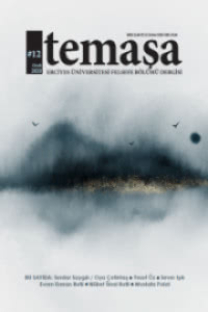Pre-Critical Kant on Traditional Logic: What is the Mistake in Syllogistic Theory?
Immanuel Kant, Eleştirel döneminin (1781’deki) başlangıcından yaklaşık yirmi yıl önce (1762), kategorik tasımlar kuramında geleneksel olarak yapılan üçlü/dörtlü şekil ayrımının ‘yanıltıcı bir incelik/karmaşıklık’ (falsche Spitzfindigkeit) olmakla kaldığını savunmuştur. Kant bu savunuyu, (i) Aristoteles’in mükemmel kiplerinin, en geniş anlamıyla akıl yürütmenin genel kuralı tarafından dayatılan ve birinci şekil olarak adlandırılan terimler düzenini örnekleyen yegâne ‘saf’ kipler olmasına ve (ii) aynı kuramdaki eksik kiplerin her birinin bu dördünden bir tanesine ‘indirgenebilir’ olmasına dayandırmıştır. Kant’ın, kategorik tasımlar kuramının standart indirgeme planını, verilen eksik kipin öncüllerinde birinci şekli ‘yeniden oluşturmaya’ yarayacak talimatlar dizisi olarak yorumlamasında gerçekten de düpedüz mantıksal sorunlar bulunmaktadır. Ne var ki asıl sorun, Kant’ın yukarıda anılan iki noktadan, ‘yanıltıcı incelik savını’ (YİS) haklılaştırmak için yararlanma biçimindedir ki bu sorun da, savın kendisinin uygun/doğru yorumu sorununa dönüşmektedir. Bu çalışma YİS’nin, görünenin aksine, belirli herhangi bir anlam taşımıyor olabileceğini göstermeye çalışmaktadır; bunun için de ilk olarak Kant’ın, YİS’nin altında yatan ve tasımsal aracılık fikrini merkez alan kendi özel yargı ve akıl yürütme anlayışını sunup değerlendirmekte, sonra da YİS’nin, hem Kant’ın anlayışına hem de çıkarım ve dedüksiyon hakkındaki genel olgulara yanıt veren makul bir yorumunun yapılamadığını göstermektedir. Çalışma bu olumsuz neticeyi, Kant’ın salt mantıksal konuları ele alırken betimleyici ve kural koyucu iki bakış açısı arasında gidip gelmesine bağlamayı önererek sonlanmaktadır.
Anahtar Kelimeler:
geleneksel mantık, tasım şekli, yargı, akıl yürütme, aracılık, Kant
Pre-Critical Kant on Traditional Logic: What is the Mistake in Syllogistic Theory?
Immanuel Kant held nearly two decades before (1762) the beginning of his ‘Critical period’ (1781) that the traditional tripartite/quadripartite division of the figures in categorical syllogistic remained a ‘mistaken subtlety’ (falsche Spitzfindigkeit), given (i) that the Aristotelian perfect moods were the only ‘pure’ patterns of reasoning that exemplify the term order – called the first figure – prescribed by the general rule of ratiocination per se, and (ii) that every imperfect mood in the same theory could be ‘reduced’ to one of those four. There really are sheer logical problems, already noted in the literature, in Kant’s reading of the standard reductive scheme for categorical syllogistic as a set of instructions for restoring the first figure within the premises of a given imperfect mood. However, the real issue is the way Kant benefits from these points to justify his ‘mistaken subtlety thesis’ (MST), which translates in turn into the issue of the correct interpretation of the thesis itself. This paper aims to show that, contrary to appearance, MST might fail to make any definite sense; to that end, it first presents and evaluates Kant’s own special conception of judgment and reasoning that centers around the notion of syllogistic mediation, on which basis Kant states MST; then it shows that a tenable reading of MST answering to the Kantian conception and to common facts about inference and deduction cannot be made. The paper concludes by proposing to connect this negative result to Kant’s wavering between descriptive and prescriptive perspectives on purely logical matters.
Keywords:
traditional logic, syllogistic figure, judgment, reasoning, mediation, Kant,
___
- Anderson, R. L. The Poverty of Conceptual Truth: Kant’s Analytic/Synthetic Distinction and the Limits of Metaphysics. Oxford: Oxford University Press, 2015.
- Aristotle. Posterior Analytics. Translated with a commentary by Jonathan Barnes, Oxford: Oxford University Press, 1993.
- Aristotle. Prior Analytics. Translated with introduction, notes and commentary by Robin Smith, Indianapolis: Hackett Publishing, 1989.
- Arnauld, Antoine and Pierre Nicole. La Logique ou l’Art de Penser. Paris: Gallimard, 1992.
- Cassin, Barbara (ed.). Dictionary of Untranslatables: A Philosophical Lexicon. Translated by Steven Rendall, Christian Hubert, Jeffrey Mehlman, Nathanael Stein, and Michael Syrotinski, Princeton: Princeton University Press, 2014.
- Corcoran, John (ed.). Ancient Logic and its Modern Interpretations: Proceedings of Buffalo Symposium on Modernist Interpretations of Ancient Logic, 21 and 22 April, 1972. Dordrecht: D. Reidel Publishing, 1974.
- Corcoran, John. “Conceptual Structure of Classical Logic,” Philosophy and Phenomenological Research 33, no: 1 (Sep. 1972): 25-47.
- Kant, Immanuel. Introduction to Logic – The Mistaken Subtilty of the Four Syllogistic Figures. Translated by Thomas Kingsmill Abbott, with a few notes by Coleridge, London: Longsman, Green, & Co, 1885.
- Kant, Immanuel. Theoretical Philosophy, 1755-1770. Translated and edited by David Walford, in collaboration with Ralf Meerbote, New York: Cambridge University Press, 1992.
- Londey, David and Carmen Johanson. The Logic of Apuleius (Including a complete Latin text and English translation of the Peri Hermeneias of Apuleius of Madaura). Leiden: E. J. Brill, 1987.
- Lu-Adler, H. “Kant and the Normativity of Logic,” European Journal of Philosophy 25, no: 2 (2017): 207-230. Lukasiewicz, Jan. Aristotle’s Syllogistic from the Standpoint of Modern Formal Logic. London: Oxford University Press, 1957.
- Myrstad, Johan Arnt. “Kant’s Treatment of the Bocardo and Baroco Syllogisms”, in Law and Peace in Kant's Philosophy/Recht und Frieden in der Philosophie Kants: Proceedings of the 10th International Kant Congress/Akten des X. Internationalen Kant-Kongresses, Edited by Margit Ruffing, Guido A. De Almeida, Ricardo R. Terra & Valerio Rohden, 163-173. Berlin: Walter de Gruyter, 2008.
- Nussbaum, Charles. “Criticial and Pre-Critical Phases in Kant’s Philosophy of Logic”, Kant-Studien 83, no: 3 (1992): 280-293.
- Parsons, Terence. Articulating Medieval Logic. Oxford: Oxford University Press, 2014.
- Patzig, Günther. Aristotle’s Theory of the Syllogism: A Logico-Philological Study of Book A of the Prior Analytics. Translated by Jonathan Barnes, Dordrecht: D. Reidel Publishing, 1968.
- Rose, Lynn E. “Aristotle’s Syllogistic and the Fourth Figure,” Mind 74, (1965): 382-389.
- Tolley, Clinton. “Kant on the Nature of Logical Laws”, Philosophical Topics 34, no: 1 & 2 (2006): 371-407.
- Vanzo, Alberto. “Kant’s False Subtlety of the Four Syllogistic Figures in its Intellectual Context” in The Aftermath of Syllogism: Aristotelian Logical Argument from Avicenna to Hegel, Edited by Luca Gili and Marco Sgarbi, 157-190. London: Bloomsbury Publishing, 2018. Wilson, Kirk D. “The Mistaken Simplicity of Kant’s Enthymematic Treatment of the Second and Third Figures,” Kant-Studien 66, no: 1-4 (1975): 404-417.
- ISSN: 2148-371X
- Yayın Aralığı: 2
- Başlangıç: 2014
- Yayıncı: Prof. Dr. Arslan Topakkaya / Erciyes Üniversitesi Felsefe Bölümü
